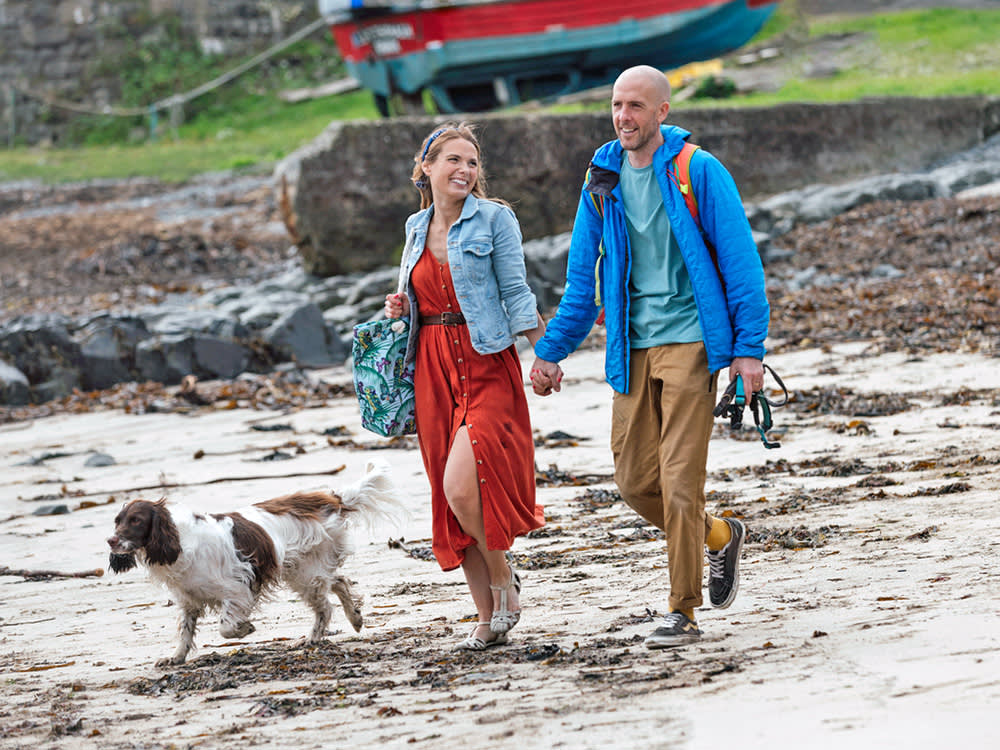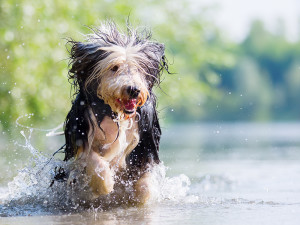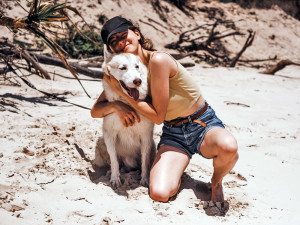
Share Article
Sea, sand and strolls with your dog – can you think of a more idyllic lifestyle? With over 5.3 million residentsopens in new tab living in coastal towns in England and Wales, and coastal areas replacingopens in new tab London as the most-searched locations for property buyers since 2020 (no surprise there), for many of us, the draws of seaside living with your pup are crystal clear. And while some dogs are more suited to swimming in the sea than others, most dogs will absolutely love the chance to run with wild abandon along the beach with the sea breeze in their fur and the sand beneath their paws. Let’s dive in to everything you need to know about life by the sea with your dog.
Prepare your pup for the beach
Whether you and your dog have just moved to the seaside, or you already live there and are planning to adopt a canine companion, it’s important to prepare your pup for the new experience of visiting a beach.
Socialisation
Whether you have a puppy or a new adult dog, socialisation is paramount, which is about introducing them to new people, stimuli, animals and environments. Some initial general steps for socialising a new dog include:
Sitting with your dog outside your house and watching as friends or neighbours do their daily activities.
Introducing your dog to all different kinds of people: babies, children, elderly people, those of all genders, races, sizes and shapes, dressed in all sorts of clothing and carrying all kinds of things – skateboards, bikes, umbrellas, walking sticks, plastic bags, wheely suitcases etc.
Taking your dog for trips in the car or walks around different areas to get them used to all types of excursions.
Letting your dog walk over, under and around various obstacles with varied textures.
Taking your dog to socialisation or puppy classes so they have the chance to meet other dogs of all sizes and learn how to interact safely and calmly with them.
When it comes to getting them used to the beach itself, pick a quiet time of day to start with and walk your dog there a few times on the lead, so they become familiar with the sights, sounds and textures of the sand and water – and give them plenty of treats along the way for each new achievement.
If a dog has negative experiences with something early on, they may learn to be nervous or afraid around them. For example, bringing a puppy to a large crowded beach the day after being adopted is potentially damaging. So while you might be excited to show off your new dog, you could actually cause them to associate the beach with fear if you do it too soon. It’s much better for your dog to meet people and dogs one or two at a time at first, and have those people provide treats, toys and gentle touching in a calm setting. Exposure to people and other dogs that result in positive experiences for your pup provides proper socialisation. Being frightened and overwhelmed does not.
Are dogs allowed at the beach?
Before you head out to the beach, make sure that your dog is allowed to join you. Some beaches may have restrictions on where dogs can go, while others may not be ideal due to size or terrain. To determine if dogs are allowed, check out your chosen beach’s dog-friendly status on The Beach Guideopens in new tab. The beach’s local council will also have information on their website. And be sure to clean up after your dog at the beach, just as you would anywhere else.
Pack the essentials
Bucket and spade aside, there are a few things you should take with you to the beach when you head out with your pup.
Collapsible water and food bowls: if you’re planning a long walk (maybe even followed by an afternoon at the pub), you should bring both food and water bowls with you, plus some fresh water in a bottle to top up the bowl if you won’t have access to drinking water on the walk. If you’re going to be out for a long time during your dog’s usual mealtimes, bring some food with you, too, so as not to disrupt their schedule.
Treats: dogs will do (nearly) anything for treats, and it’s a great way to get them to trust new people and experiences. So pack a bag of high-value treats and dish them out for good behaviour and offer them to strangers who are trying to befriend your dog – they’ll be making beach buds with everyone in no time.
Toys and balls: get your dog’s energy out by bringing toys you can throw for them, tug toys for a bit of rough and tumble in the sand, and puzzle feeders and Kongs if you’re going to need to keep them busy during your post-walk activity.
Weather-appropriate gear: is it going to be cold, hot, raining? Probably all three in quick succession in the UK. Either way, make sure your pup is equipped with everything they need to face the elements (see more below), including a towel to dry them off after a dip in the sea.
Dog life jacket: while many dogs have a natural instinct to swim, it’s important to remember that not all dogs can swim. Some breeds are also physically better suited to swimming, whereas others might be frightened or have difficulty swimming. If your dog falls into the latter category, make sure they‘re wearing a properly fitted dog life jacket.
Protect paws and ears
Salt can be irritating to paws and skin, too. Rinse salt water and sand from your dog’s coat after swimming. Always clean and dry ears after a swim. Water that remains in ears, especially from the sea, can result in a bacterial ear infection.
Is it safe for dogs to swim in the sea?
In general, it is safe for dogs to swim in the sea – it can be great exercise for them. But before heading out to the water, take note of a few precautions.
Check the water conditions. Your dog may be a strong swimmer, but large rolling waves can still be very dangerous. Before you take your dog to the beach, it’s important to check the water conditions. Some beaches may have rip currents or other hazards that could be dangerous for dogs. In these conditions, you might want to keep your dog on a lead so that they can’t go out too far.
Beware of other animals and wildlife. Scan both the water and sand for crabs and other marine life, which can be dangerous for dogs. Be aware of sea lice that can cause itchy red bumps on dogs. Prevent your pup from rolling in or eating anything that could make them sick. Be especially mindful of areas that have a high volume of jellyfishopens in new tab. Another tip: discourage your dog from eating sand when playing fetch at the beach. Too much sand ingested can create an impaction in their intestine causing their intestinal tract to close up.
Monitor salt water ingestion. Your dog may want to lap up the salty sea water if they’re thirsty, but the salt, bacteria and parasites in the water can make them sick. While at the beach, dogs can get dehydrated quickly in the sun, so it is imperative that you prevent your dog from drinking salt water by providing them with plenty of fresh water. Drinking salt water can lead to saltwater poisoning, vomiting after swimming and ‘beach diarrhoea’. A few gulps of salt water won’t harm your dog, but watch for vomiting and early neurological signs of salt poisoning, such as dullness and depression. Remember, it is also possible for your pup to have too much water – be careful of water intoxication.
Is the weather suitable for a beach day?
While scorching hot days are not exactly a common occurrence in the UK, they do happen. Just like people, dogs are at risk for heatstroke and dehydration when temperatures rise. If you’re uncomfortable in the sun, your dog probably is, too. Make sure they always have access to fresh water and shade when outside, and you can also give them ice-filled Kongs or a frozen water bottle to keep them cool.
Sunscreen: if it’s a particularly hot day, limit your dog’s exposure during peak sun hours (between 10am and 3pm) and apply doggy sunscreenopens in new tab 30 minutes before going outside.
Protect their paws from hot sand: hot sand (and pavement) can easily exceed comfortable temperatures for delicate paw pads leading to blisters. If the sand is too hot for you to walk barefoot, then it’s too hot for your pup’s paw pads. Save your beach trip for a cooler day, or go in the early morning or late evening to avoid the heat.
Heat-stroke: running on the sand is strenuous exercise, and this can easily lead to heat-stroke in dogs. And never, ever leave your dog unattended in your car in the summer months – even while you’re loading and unloading your car at the beach. Heat-stroke and death can occur within minutes even in warm temperatures.
More likely at the British seaside is that the weather will be blustery, cold and raining – so while you should never force your dog to go out in really nasty weather, there are plenty of ways you can ensure they stay safe, dry and warm if you do.
Dog coats: if your dog has naturally has a long, thick coat – think Husky or Pomeranian – they probably do not need to wear a coat or jacket. But if your dog is slick-coated, very young, elderly or suffering from a medical condition like arthritis, a coat can help keep them comfortable when temperatures drop. Signs your dog needs a coat include: shivering, whining or vocalising their discomfort, expressing anxiety or nervousness, lifting their paws off the ground when walking and stopping play or whatever activity they’re doing.
Colds: dogs can get colds, too. And while some dogs might insist on taking a dip in the sea no matter how freezing it is (don’t worry, they’ll run out just as fast if it really is too cold for them), you can avoid them catching a cold by ensuring you towel them off thoroughly afterwards.
Dry paws and noses: in colder temperatures, many dogs’ noses and paws can become dry and start to crack. Thankfully, there are balmsopens in new tab on the market you can apply after a cold walk to help.
While you should obviously never choose the pup you’re going to adopt based on whether they’re a ‘classic’ beach dog or not, here are some breeds that will likely do particularly well at the seaside (in no particular order). However, it’s important to remember that breed characteristics are generalised and each dog is an individual, so no matter what activity you’re doing with your dog, go at their pace and take your cues from their behaviour.
English Setter
The graceful English Setter is a gentle and friendly breed, known for being good with children – although we can’t promise they won’t knock over their sandcastles. Compared to other Setters, they are known for their calm, sociable and mild-mannered dispositions. But what makes them so well-suited for seaside living is that they absolutely love being in and around water, and will gladly dive into the sea for a good, long swim. Just don’t forget to comb their coats when you get home to avoid tangles!
Labrador Retriever
One of the best dogs for swimming, Labs’ muscular body and wide, otter-like tail means they’re perfectly designed for a great time in the water. Full of energy and an eagerness to learn and play, dog parents can also train their Labs for dock diving, which combines running, jumping, swimming and retrieving. Their friendly and outgoing personalities means they’ll be bounding up to strangers and other dogs to play, making them great wingmen for making new friends if you’ve just moved there.
Newfoundland
The OG water dogs, Newfoundlands hail from Canada, where they were originally bred to work on ships. These big bois have partially webbed paws and a thick, water-resistant coat, which makes them very adept at swimming. They’re also strong enough to rescue an adult human from drowning – the David Hasselhoff of dogs? Don’t let their size fool you either, they are as friendly and affectionate as they come, known for being a great family dog thanks to their patience and love of children. Well suited to most British (read: cold) weather, you should keep their colder climate heritage in mind on those rare sunny seaside days, as hot weather can pose health risks if proper precautions are not taken.
Poodle
Although you may associate Poodles with being impeccably groomed show dogs, they actually have a history as water dogs and were originally bred to hunt waterfowl. Their famously curly coat is water-resistant and won’t weigh them down as they swim – which they absolutely love to do. Good with kids and strangers, Poodles are among the world’s most intelligent dog breeds, which makes them highly trainable and very adaptable – all very useful skills for seaside living. They can be a little prone to nervousness in new places or around other dogs, so take it slow and build up their tolerance over a few visits to the beach first.
Portuguese Water Dog
Originally bred to work alongside fishermen, Portuguese Water Dogs are intelligent, fiercely loyal and affectionate. These energetic dogs sport curly or wavy fur that doesn’t shed often but does need regular grooming, especially after a dip in the sea. They love (and need) lots of exercise, so if you’re the active type, this is the dog for you. Make sure to take them for a swim or other heart-pumping activity for at least 30 minutes each day, and you’ll have a happy little water baby on your hands.
Border Collies
Border Collies are full of energy and always up for a challenge. Renowned for their natural herding instincts and ability to learn and follow commands, Border Collies’ super-smart minds make them perfect candidates for playing fetch and learning tricks at the beach. Get creative and make assault courses featuring cones, buckets, balls, surfboards and whatever fun items you can find to take with you. Border Collies are also great swimmers who enjoy splashing around in the water or accompanying their pet parents on longer swims in the sea.
Golden Retriever
Is there anything these sociable, devoted and intelligent dogs can’t do? We don’t think so – and frolicking at the beach is just one of their many talents. Good first dogs for new pet parents, Golden Retrievers are super-friendly and will love the chance to bound around the beach making bffs with everyone. They’re also well-behaved and have excellent recall, both of which are handy for off-lead runs. Their famous golden coat also helps repel water when they go for a splash – which is often!
Jack Russell Terrier
If you’ve got a smaller dog in mind, then a Jack Russell Terrier is the perfect choice for seaside dwellers as they are very capable of joining you on an up-tempo run along the sand. These pups thrive on physical activity and mental stimulation, making them perfect for families and adventures by the sea. Jack Russells excel in agility training, flyball and other canine sports that challenge their athleticism and mental prowess. They can swim, but take it slow and introduce them to shallow waters first – use the aforementioned doggie life jacket as a precaution. Given their compact size, Jack Russells are also ideal for those who live in smaller spaces.
Barbet
The friendly and sociable Barbet – pronounced ’bar-bay’, which is just perfect for telling people that your dog’s job is ‘just beach‘ – are named for their hairy chin (barbe means beard in French), and have been described as ‘a Muppet come to life’. These shaggy, cheerful pups are agile athletes who are also keen hunters and tireless swimmers. Make sure you’re prepared for daily grooming sessions after a roll in the sand or dip in the water, though.
Irish Water Spaniel
Among the oldest and most distinctive Spaniels – although these pups behave more like Retrievers and look more like Poodles – the Irish Water Spaniel is known for their love of water, intelligence and silly sense of humour. They are dedicated to their roles as companions, sporting dogs and all-around entertainers – they’re the best friend who is always up for anything.

Ro Elfberg
Ro previously served as Kinship’s Senior Editor. Now a freelancer, she has written and copy-edited for British Vogue, Glamour, DICE and of course, Kinship. When she’s not being manipulated into dishing out Dreamies to Kobe the cat, she spends her free time trying to convince her snake, Butters, to wear a tiny hat.
Related articles
![A woman wearing sunglasses, yellow trousers and a coat with a fluffy collar stands in front of a market stall selling knick-knacks and prints, which has a Union Jack flag draped over the front of it. She is holding a small dog on a lead who is wearing a red checkered jacket. Behind her is a London bus.]()
10 Breeds of Dogs For City Living
Because taking a St Bernard on the tube is do-able, it's not the most practical
![a boy cuddles a small dog while standing next to a narrowboat]()
How To Be a Great Dog Parent In a Tiny Living Space (From People Who Know)
Whether you live in a small flat, a van or a boat, these pooch and human partnerships prove you can thrive in a small space with your dog
![A German Shepherd and a Spaniel sitting at a pub table with their paws on the table and two beers in front of them.]()
10 Breeds of Dog Most Likely To Accompany You To The Pub
Who wouldn’t want to bring their best friend along for a pint?
![girl in a yellow top and baseball cap hugs a big fluffy white dog on a beach]()
Is It More Ethical to Adopt a Dog From Overseas Or From the UK?
You’ve chosen to adopt a dog, congratulations! But with dogs in need both here and abroad, which route should you take?
![Portrait of six pure-bred Husky puppies sitting side by side on a table while their breeder tried to arrange them for a photo in the background]()
12 Red Flags You Should Watch Out For in a Dog Breeder
Look out for untrustworthy breeders – and report them








